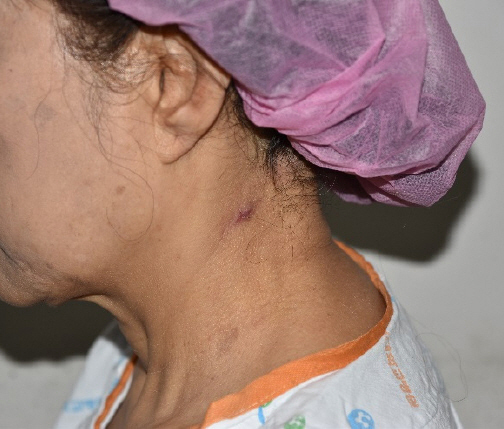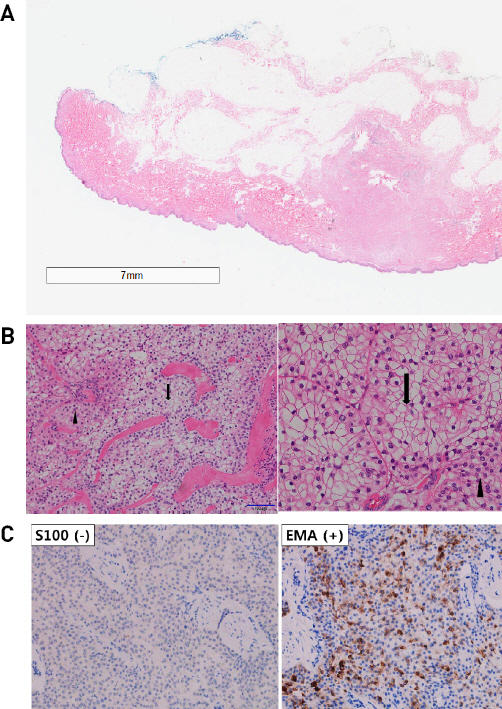1)) Lever WF, Castleman B. Clear cell myo-epithelioma of the skin;report of ten cases. Am J Pathol. 1952;28:691-699.


2)) Kersting DW. Clear cell hidradenoma and hidradenocarcinoma. Arch Dermatol. 1963;87:323-333.


3)) Johnson BL Jr, Helwig EB. Eccrine acrospiroma:A clinicopathologic study. Cancer. 1969;23:641-657.


4)) Winkelmann R. Solid-cystic hidradenoma of the Skin. Clinical and histophthologic study. Arch Dermatol. 1968;97:651-661.


5)) Ashley I, Smith-Reed M, Chernys A. Sweat gland carcinoma:Case report and review of the literature. Dermatol Surg. 1997;23:129-133.

6)) El-Domeiri AA, Brasfield, RD, Huvos AG, Strong EW. Sweat gland carcinoma:a clinico-pathologic study of 83 patients. Plast Reconstr Surg. 1971;173:270-274.
7)) Lee JH, Cho SI, Do NY, Dong GW. A Case of Giant Malignant Clear Cell Hidradenoma. Korean J Otorhinolaryngol-Head Neck Surgery. 2005;48:1305-1308.
8)) Weyers W, Euler M, Diaz-Cascajo C, Schill WB, Bonczkowitz M. Classification of cutaneous malignant melanoma:a reassessment of histopathologic criteria for the distinction of different types. Cancer. 1999;86:288-299.


9)) Mehregan AH, Hashimoto K, Rahbari H. Eccrine adenocarcinoma:A clinicopathologic study of 35 cases. Arch Dermatol. 1983;119:104-114.


10)) Wong TY, Suster S, Nogita T, Duncan L, Dickersin RG, Mihm MC Jr. Clear cell eccrine carcinomas of the skin. A clinicopathologic study of nine patients. Cancer. 1994;73:1631-1643.


11)) Orlandi RR, Sercarz JA, Doberneck SA, Calcaterra TC. Malignant clear cell hidradenoma of the upper lip. Head Neck. 1994;16:443-449.


12)) Kazakis A, Wood C, Anderson R. Metastatic malignant clear cell hidradenoma associated with bullous pemphigoid. Br J Dermatol. 1988;118:819-826.


13)) Lee JY, Kang BS, Shim HS, Song IH, Kim M, Lee SH, Chung HW, Kee MH, Shin MJ. Clear Cell Hidradenoma:Characteristic Imaging Features on Ultrasonography, Computed Tomography, and Magnetic Resonance Imaging. J Ultrasound Med. 2018;37:1993-2001.



14)) Headington JT, Niederhuber JE, Beals TF. Malignant clear cell acrospiroma. Cancer. 1978;41:641-647.


15)) Wong TY, Suster S, Nogita T. Duncan LM, Dickersin RG, Mihm MC Jr. Clear cell eccrine carcinomas of the skin. A clinicopathologic study of nine patients. Cancer. 1994;73:1631-1643.


16)) Will R, Coldiron B. Recurrent clear cell hidradenoma of the foot. Dermatol Surg. 2000;26:685-686.


17)) Liapakis IE, Korkolis DP, Koutsoumbi A, Fida A, Kokkalis G, Vassilopoulos PP. Malignant hidradenoma:a report of two cases and review of the literature. Anticancer Res. 2006;26:2217-2220.

18)) Park SH, Kang SG, Choi HJ. Hidradenoma of the Chin. J Craniofac Surg. 2017;28:e454-455.











